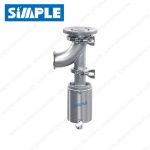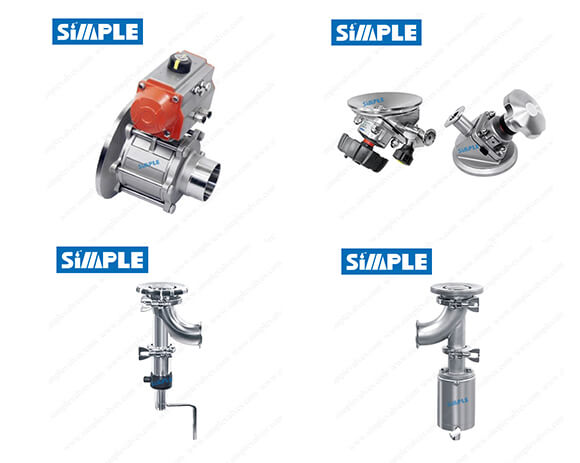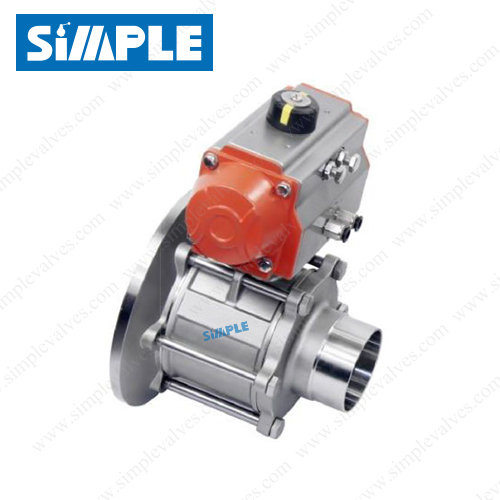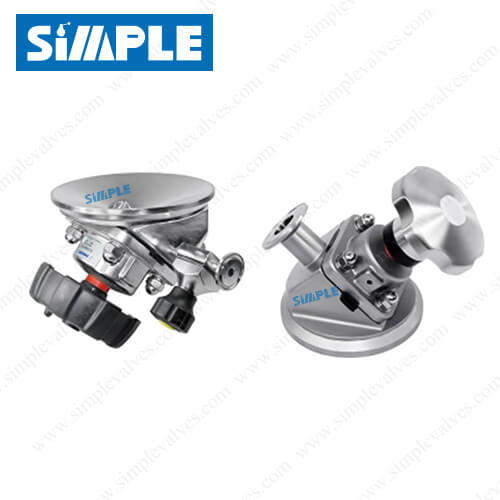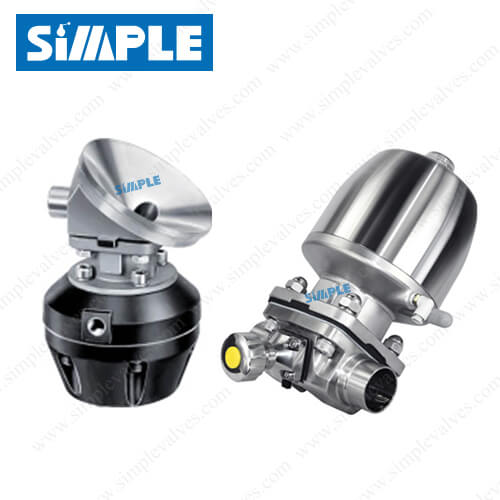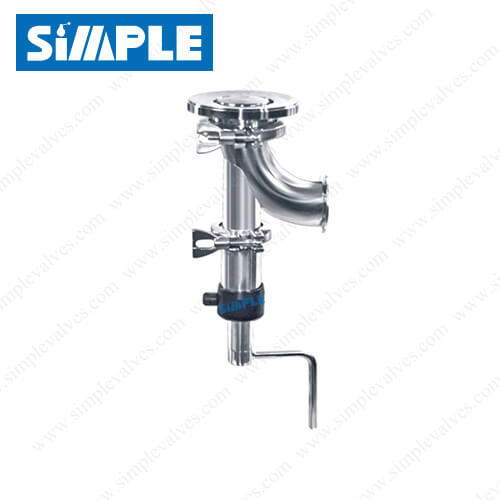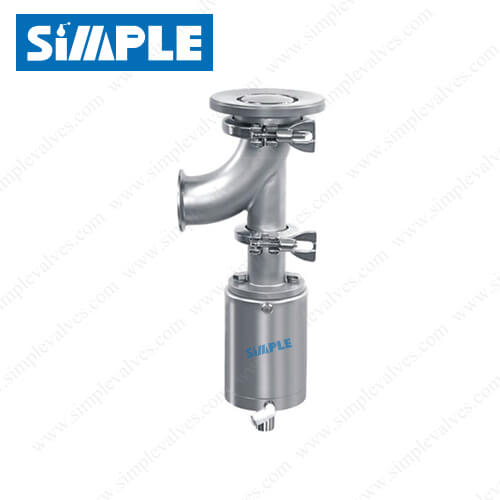Sanitary Tank Bottom Valves
SIMPLE SV-10 series Sanitary Tank Bottom Valves are pneumatically or manually operated. They are mostly assembled at the bottom of the tanks/vessels for drainage. They are widely used in the dairy, beverage, food processing, chemical, and the pharmaceutical industries.
Tank Bottom Ball Valve, Sanitary Design, Manual Type
Reference: SV-2MTBCSizes available: 1.5" to 3", DN40 to DN80
End connection: Tank Bottom
Food Grade Ball Valve, Sanitary Tank Bottom Ball Valve, Pneumatic Type
Reference: SV-2PTBCSizes available: 1.5" to 3", DN40 to DN80
End connection: Tank Bottom
Bottom Outlet Valve, Sanitary Tank Bottom Diaphragm Valve, Manual Type
Reference: SV-4MTBSizes available: 3/4" to 4"
End connection: tri-clamp, or butt-weld
Air Operated Diaphragm Valve, Sanitary Tank Bottom Type
Reference: SV-4PTBSizes available: 3/4" to 4"
End connection: tri-clamp, or butt-weld
Pneumatic Sanitary Tank Bottom Valve, Discharge Valve
Reference: SV-10PDSSizes available: 1 1/2" to 3" (DN40-DN80)
End connection: butt-welded, sanitary tri-clamp
Manual Sanitary Tank Bottom Valve, Discharge Valve
Reference: SV-10MDSSizes available: 1 1/2" to 3" (DN40-DN80)
End connection: butt-welded, sanitary tri-clamp
A sanitary tank bottom valve is a valve that is fitted at the bottom of a tank to empty the tank, filling of the tank or draining it when the need arises. The processes occur with a minimal dead leg.
The sanitary tank bottom valve has a conical shape that makes it possible to drain the tank while preventing the occurrence of dead legs and areas that trap dirt within the tank.
They are widely used in the dairy, beverage, food processing, chemical, and the pharmaceutical industries.
Types of Sanitary Tank Bottom Valves
There are several types of sanitary tank bottom valves. Some of the most common types include the following:
The sanitary tank bottom ball valves come in different sizes and materials. It handles a range of temperatures of between -30 and 130 degree Celsius. It handles a maximum pressure of 10 bar, making it one of the best valves for a tank. The valve operates on a minimal torque, making it easy to use and economical in terms of power use.
The valve handle can be mounted on the tank wall despite the fluid that is flowing ion. It can be easily replaced despite the kind of connection in the tank.
The tank bottom diaphragm valves work in a simple principle. Under the usual sate, the diaphragm is closed, and at this time, it is clung to a cavity on the valve body. It shuts flow through a pipeline when required to clean or drain the water within the tank.
For the valve connection, one can choose to either clamp it or weld it in the tank.
The mix proof sanitary tank bottom valves follow an automatic operation through a single or double working pneumatic actuation system. When compressed air is supplied to the valve, the valve shaft moves to open the valve in the closed state. After that, the seat of the valve opens up in the tank. It, therefore, prevents the unplanned opening of the tank when excessive pressure is exerted on the pipeline. There are still many other types of sanitary tank bottom valves apart from the ones highlighted above.
Ways of Fixing the Sanitary Tank Bottom Valve
There are two ways of fixing the sanitary tank bottom valves. The methods include the following:
— Bolting
Bolting involves fixing the sanitary tank bottom valves using some nuts. The metallic bolts hold the valves in place firmly to serve its purpose.
— Welding
Welding involves using some high-temperature electric heat to hold the valves into place. The valve is welded on the bottom where the draining and emptying mostly takes place.
Areas of Usage
The sanitary tank bottom valves have extensive usage. It is mostly used in the beverage industries, chemical, pharmaceutical, and food-processing industries. These are some of the places where emptying and draining are primarily done in the manufacturing processes.
The valve simplifies the activities minimizing the time required for the process of manufacturing beverages and chemicals.
Design Features of Sanitary Tank Bottom Valves
The sanitary tank bottom valves are designed in a specific way to enable them to work effectively. The design is made such that every detail that goes in the final valve aids it in its functioning. The design contains the following details for its optimum performance.
The design of the sanitary valves is made following the maximum health and sanitary standards. This is to ensure that the fluid within the tank does not get contaminated. Remember the pipes are used in beverages manufacturing as well as pharmaceuticals. Of course, human beings will take the beverages and hence the hygienic pursuit in the making of the valves.
The 3A standard was developed for milk pipe fittings in the 1920s. Since then, it remains to be a set of standards for all the pipes that carry fluids more so for human consumption.
The sanitary valves are made such that they do not retain any fluid within the system. They do an absolute discharge that leaves both the pipe and the tank clean.
It is one of the measures that the manufacturers of the valves have taken since the retention of the fluids might contaminate the fresh fluids. It could be dangerous to human health more so when the valve system is used in the beverages industry.
The sanitary tank bottom valves have the normally closed and the normally open functions. The two are interchangeable by merely rotating the cylinder within an angle of 180 degrees. This makes the process of opening and closing the valves very easy.
After the sanitary valve has been connected to the tank through welding, there is still a possibility of rotating the valve for a 360-degree adjustment. The possibility of change improves the flexibility of the way the sanitary valve works.
To observe the working of the sanitary valve, there is an open lantern where this can be done. Therefore, the examination of the shaft sealing and its operation is possible. It implies that all the necessary corrections and adjustments can be done on the valve to enhance its working.
The sanitary valves have an easy assembly and disassembly through loosening the clamp at the center of the body of the valve. It makes it easy to make all the necessary adjustments on the valve.
How to Select a Good Sanitary Tank Bottom Valve
There are a variety of valves in the market today and choosing the best one becomes a battle of evaluation. Some of the things to consider when buying a sanitary valve include the material, size needed, the purpose, and the method of connection. Others considerations include the resistance of the valve, the inner surface of the valve and the valve actuation.
As a manufacturer of stainless steel sanitary valves, SIMPLE VALVES aims to arm its potential customers with information that would help them in making an informed decision.
Our sales representatives are ready to help, please feel free to email us at sales@simplevalves.com or submit your request directly in below form.





